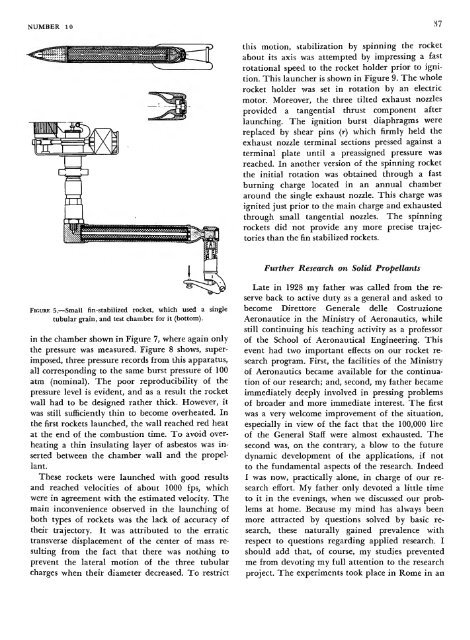FIRST STEPS TOWARD SPACE - Smithsonian Institution Libraries
FIRST STEPS TOWARD SPACE - Smithsonian Institution Libraries
FIRST STEPS TOWARD SPACE - Smithsonian Institution Libraries
Create successful ePaper yourself
Turn your PDF publications into a flip-book with our unique Google optimized e-Paper software.
NUMBER 10<br />
FIGURE 5.—Small fin-stabilized rocket, which used a single<br />
tubular grain, and test chamber for it (bottom).<br />
in the chamber shown in Figure 7, where again only<br />
the pressure was measured. Figure 8 shows, superimposed,<br />
three pressure records from this apparatus,<br />
all corresponding to the same burst pressure of 100<br />
atm (nominal). The poor reproducibility of the<br />
pressure level is evident, and as a result the rocket<br />
wall had to be designed rather thick. However, it<br />
was still sufficiently thin to become overheated. In<br />
the first rockets launched, the wall reached red heat<br />
at the end of the combustion time. To avoid overheating<br />
a thin insulating layer of asbestos was inserted<br />
between the chamber wall and the propellant.<br />
These rockets were launched with good results<br />
and reached velocities of about 1000 fps, which<br />
were in agreement with the estimated velocity. The<br />
main inconvenience observed in the launching of<br />
both types of rockets was the lack of accuracy of<br />
their trajectory. It was attributed to the erratic<br />
transverse displacement of the center of mass resulting<br />
from the fact that there was nothing to<br />
prevent the lateral motion of the three tubular<br />
charges when their diameter decreased. To restrict<br />
this motion, stabilization by spinning the rocket<br />
about its axis was attempted by impressing a fast<br />
rotational speed to the rocket holder prior to ignition.<br />
This launcher is shown in Figure 9. The whole<br />
rocket holder was set in rotation by an electric<br />
motor. Moreover, the three tilted exhaust nozzles<br />
provided a tangential thrust component after<br />
launching. The ignition burst diaphragms were<br />
replaced by shear pins (r) which firmly held the<br />
exhaust nozzle terminal sections pressed against a<br />
terminal plate until a preassigned pressure was<br />
reached. In another version of the spinning rocket<br />
the initial rotation was obtained through a fast<br />
burning charge located in an annual chamber<br />
around the single exhaust nozzle. This charge was<br />
ignited just prior to the main charge and exhausted<br />
through small tangential nozzles. The spinning<br />
rockets did not provide any more precise trajectories<br />
than the fin stabilized rockets.<br />
Further Research on Solid Propellants<br />
Late in 1928 my father was called from the reserve<br />
back to active duty as a general and asked to<br />
become Direttore Generale delle Costruzione<br />
Aeronautice in the Ministry of Aeronautics, while<br />
still continuing his teaching activity as a professor<br />
of the School of Aeronautical Engineering. This<br />
event had two important effects on our rocket research<br />
program. First, the facilities of the Ministry<br />
Of Aeronautics became available for the continuation<br />
of our research; and, second, my father became<br />
immediately deeply involved in pressing problems<br />
of broader and more immediate interest. The first<br />
was a very welcome improvement of the situation,<br />
especially in view of the fact that the 100,000 lire<br />
of the General Staff were almost exhausted. The<br />
second was, on the contrary, a blow to the future<br />
dynamic development of the applications, if not<br />
to the fundamental aspects of the research. Indeed<br />
I was now, practically alone, in charge of our research<br />
effort. My father only devoted a little time<br />
to it in the evenings, when we discussed our problems<br />
at home. Because my mind has always been<br />
more attracted by questions solved by basic research,<br />
these naturally gained prevalence with<br />
respect to questions regarding applied research. I<br />
should add that, of course, my studies prevented<br />
me from devoting my full attention to the research<br />
project. The experiments took place in Rome in an<br />
37

















